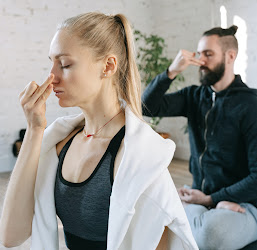Did you know Oxygen can kill you?
There’s a lot of information around about breathing – and much of it is inaccurate and unhelpful. So, in this article I’m going to bust some breathing myths! Then, with myths busted, I’ll help you work out the quality of your own breathing and give you some techniques to breath in a way that is helpful to your health rather than damaging it!
5 Breathing myths busted
If you would rather you can watch a video where I share these 5 myths for Swindon Speakers club.
Myth No 1
So often I’ve heard yoga or meditation
teachers say: ‘Begin by focusing on your breathing. You don’t have to change
it.’
 Yet,
it’s impossible for us to think about our breathing and it not change. The simple act of awareness changes everything
and that goes well beyond breathing, but let’s not get into quantum
stuff!
Yet,
it’s impossible for us to think about our breathing and it not change. The simple act of awareness changes everything
and that goes well beyond breathing, but let’s not get into quantum
stuff! Breathing is a reflex like our heart beating and our digestion (thank goodness for that or we would all be dead by now!) Our breathing rate changes automatically depending on the physical needs of the body – increases if we are running for example and slows down when sleeping.
Heart rate and digestion although affected by our state of mind / our stress levels, simply thinking about slowing or speeding our heart or digestion has little noticeable effect. However our breath is the one reflex we are able to control easily. I share how to make it more effective at the end. The simple act of thinking about your breathing changes it!
So that’s one breathing myth busted already and I’ve hardly got started.
Myth No 2
It’s often said that we can’t survive for more than three minutes without breathing.
Yet the record for breath-holding is 24.03 min –and I’ve no idea how that’s possible either! It does take practice but this demonstrates that it is possible! There are also plenty of stories of people who have been in accidents and stop breathing for well over 3 min and unexpectedly survive unharmed to the amazement of the medical profession.
Myth No 3
Oxygen is the all-important gas in breathing and CO2 is a waste gas.
When I trained as I nurse we were told: under no circumstances increase the level of oxygen, given to an asthmatic, without a doctor’s permission. Why? Because you’ll KILL them! Yes that’s right too much Oxygen will kill you!
I know this is hard to grasp but, the
crucial element in the act of breathing, is CO2. Yes, we depend on oxygen for
life, but it’s an increase in carbon dioxide in our blood stream, rather than
the lack of oxygen, that triggers our breathing reflex. CO2 then, is crucial not simply a waste gas.
For more on why carbon dioxide is not a waste gas.
Myth No 4
The following symptoms denote stress don’t they?
Breathlessness, excessive sighing, palpitation (rapid, strong and/or irregular heartbeat), cold hands and feet, muscle pains, dizziness, exhaustion, lethargy (lack of energy and enthusiasm), anxiety, sleep disturbance, increased blood pressure, headache, disturbed concentration and memory.
Well no. They don’t. According to
Russian scientist, Professor Buteyko, these are a mere few of the many symptoms
of chronic hyperventilation. What does that mean? O2/Co2
balance in our blood, alters the pH of our blood, creating an overly acidic
system. This is a key component of the inflammation process which leads to many chronic problems.
As we’ve seen, for our body to work well it needs CO2 as much as oxygen. What
we think is stress and hard to control turns out to be symptoms of hyperventilation, which is much easier to control!
Myth No 5
Taking deep breaths helps when you’re stressed.
As mentioned in myth No 1, thinking of your breathing rather than the thing that is causing you to get anxious is helpful but not deep breathing per se. It will serve only to exacerbate the problems associated with hyperventilation mentioned above. The key is to focus on a slow out breath, not the in breath.
Improving breathing quality
1) Take a full relaxed breath (through your nose) and note the depth and quality of your breath on a 1 to 10 scale.
Notice if it’s more difficult to breathe in or out.
2) Clench your buttocks and repeat point 1. How did the tightness affect your score?
3) Now, tighten your shoulders by shrugging them or squeezing them together in your back and breathe. What is your score now?
Release and notice what is different about your breathing now. Note, where is it on the scale 1 to 10 now?
Breathing Techniques
A) The control pause
Measure your breathing health and unblock your nose
To measure your control pause, sit in a comfortable position in an upright chair, relax and breathe out. Then breathe in normally and out again, holding your nose after the out breath.
Using a stopwatch, count how many seconds
you can hold your breath, until you feel the need to breathe in again. Then, breathe
in through your nose without gulping air.
The number of seconds you counted, before breathing in, gives you your control
pause.
The ideal control pause is sixty seconds, but a control pause of forty to sixty denotes good health.
A control pause of thirty or less means you’re breathing enough for at least two people will probably have some of the symptoms of hyperventilation on a regular basis.
B) Square breathing
Square breathing also known as (box breathing), is a simple practice you can use any time in the day. You can do it anywhere – sitting in traffic, waiting for someone or for any form of transport.
It’s especially good to use first thing in the morning and last thing at night. It helps unblock your nose as does the control pause mentioned above.
I teach this to almost all my clients as it’s relaxing and helps with sleep issues. Both of which are key to better health.
You simply need to be able to count to four. Breathe in for a count of four - then hold for four counts, then breathe out for four counts and hold your breath for four counts before starting again. This is square breathing.
The pauses are the most important part of this breathing practice. You may notice this is when your thoughts will begin to still.
You can follow along with this video where I share the technique 26 min into a presentation about stress.
The effects are cumulative, so the more you introduce it into your day, the more you will benefit from lower blood pressure, improved ability to deal with difficult situations and better sleep (quantity and quality).
What changes do you notice now after just a few rounds?
c) Feldenkrais breathing
This breathing practice helps increase lung capacity, ease and function.
Use it to discover how good your breathing is and to increase control and breathing capacity:
You can follow the instruction on this video:
a. Place the depth and quality of your breath on a 1 to 10 scale – note if it’s more difficult to breathe in or out.
b. Chop up the most difficult way (in or out) first.
Repeat for 3 breaths then take a pause.
Notice any change. And then reverse the process.
c. Now place your breathing on the scale of 1to 10,
what changes do you notice?
How do you feel mentally as well as physically?
You can follow this recording, where I take a client through this practice.
Whenever you realise your breathing isn’t as good as you would like, recall a positive experience and relax with the above breathing practices. When you’re in pain remember to breathe OUT, muscles will relax more easily and pain will decrease! Square breathe at least twice a day!
Until next time, Be well.
Julie Nicholls Body~Mind Coach LCSP(Phys), IEMT, former RGN Tel: 01793 495551
For other resources about breathing:
Videos:
Learn how to improve deep breathing for stress and anxiety
Breathing function at 16min into this video
Books:
ALEXANDER STALMATSKI, Freedom from Asthma, https://amzn.to/3t3lsZi
Buteyko’s revolutionary treatment https://amzn.to/3M00ukF
Asthma free in 21days https://amzn.to/3wYeG8u
This post contains Amazon links for which I may get a small commission if you purchase through the link.


